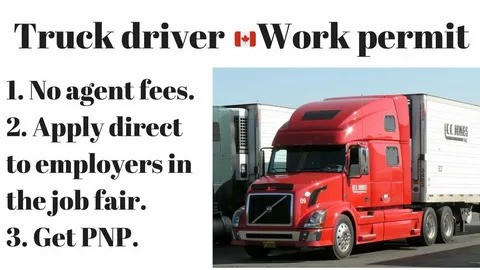Truck Driving Jobs in Canada
Truck driving is one of the most essential and in-demand professions in Canada. With vast distances separating cities, industries, and suppliers, the trucking industry is critical for keeping the economy moving. From transporting goods across provinces to delivering supplies to remote areas, truck drivers play a crucial role in ensuring that products reach their destinations on time.
The increasing demand for truck drivers has led to numerous job opportunities across the country. Truck driving jobs are not only abundant but also offer good pay, job security, and the chance to explore Canada’s scenic highways. In this article, we’ll take an in-depth look at truck driving jobs in Canada, the skills required, licensing requirements, career growth opportunities, and more.
1. Overview of the Trucking Industry in Canada
The trucking industry is a significant contributor to Canada’s economy, responsible for transporting over 90% of all consumer goods and foodstuffs across the country. Whether it’s delivering raw materials to factories, distributing products to retail stores, or shipping goods to international markets, trucking is a critical part of the supply chain. According to the Canadian Trucking Alliance, the industry employs over 300,000 drivers, and there are ongoing shortages due to the increasing demand for transportation services.
Canada’s vast geography, spanning 9.98 million square kilometers, means that efficient transportation is vital to the movement of goods across the country. Truck drivers are needed to ensure that products and materials make their way across the many miles of highways that connect Canada’s major cities and rural communities.
2. Types of Truck Driving Jobs in Canada
The trucking industry offers a wide variety of job opportunities based on the type of vehicle driven, the distance traveled, and the goods transported. Here’s a look at some of the most common types of truck driving jobs available in Canada:
a. Long-Haul Trucking
Long-haul trucking, also known as over-the-road (OTR) driving, involves transporting goods over long distances, typically across provinces or even between countries (Canada and the United States). These routes can take days or even weeks to complete.
- Job Description: Long-haul drivers transport goods across significant distances, often crossing provincial or national borders.
- Vehicles: Heavy-duty trucks and tractor-trailers.
- Work Schedule: Long-haul drivers spend extended periods away from home, sometimes working for several days or weeks before returning home for rest.
b. Short-Haul or Local Trucking
Short-haul trucking jobs involve delivering goods within a relatively short distance, usually within a city or region. These drivers typically return home every night, making it a popular choice for those seeking a better work-life balance.
- Job Description: Transport goods within a designated local area or region.
- Vehicles: Medium-sized trucks, delivery vehicles, and vans.
- Work Schedule: Shorter trips, allowing drivers to return home each day.
c. Flatbed Trucking
Flatbed truck drivers transport oversized or irregularly shaped goods that cannot fit in standard enclosed trailers. These drivers are responsible for securing cargo properly to ensure its safe transport.
- Job Description: Transport large, heavy, or irregularly shaped goods, such as construction materials, machinery, or oversized equipment.
- Vehicles: Flatbed trucks.
- Work Schedule: Varies depending on the distance of each haul, but can include both long-haul and short-haul routes.
d. Tanker Trucking
Tanker truck drivers transport liquids or gases, such as fuel, chemicals, or other hazardous materials. This type of driving requires specialized training and certifications due to the nature of the cargo.
- Job Description: Transport hazardous or non-hazardous liquids and gases.
- Vehicles: Tanker trucks.
- Work Schedule: Both long-haul and local routes are available, depending on the employer.
e. Refrigerated Trucking (Reefer)
Refrigerated truck drivers transport perishable goods such as food, beverages, or pharmaceuticals that require temperature-controlled environments.
- Job Description: Ensure the safe and timely transport of perishable goods while maintaining proper temperature controls.
- Vehicles: Refrigerated trucks (reefers).
- Work Schedule: Long-haul or short-haul routes, depending on the delivery location and cargo.
f. Owner-Operators
An owner-operator is an independent truck driver who owns their truck and contracts their services to different companies. They have more flexibility and control over their routes and schedules but also take on the responsibility of maintaining their vehicle and managing business expenses.
- Job Description: Own and operate a truck, managing both the driving and business aspects.
- Vehicles: Self-owned trucks, often heavy-duty tractor-trailers.
- Work Schedule: Highly flexible, depending on contracts and personal preferences.
3. Requirements for Truck Driving Jobs in Canada
To work as a truck driver in Canada, there are several requirements you must meet, including specific licenses, qualifications, and experience. These requirements vary depending on the type of truck you want to drive and the province you are located in.
a. Driver’s License
The most critical requirement for any truck driving job is a valid commercial driver’s license (CDL). In Canada, each province has its own system for licensing commercial drivers, but a Class 1 license (for heavy trucks) is required for long-haul or tractor-trailer driving.
- Class 1 License (for heavy vehicles): Required to drive large tractor-trailers and long-haul trucks. This is the most common license for truck drivers.
- Class 3 License: Allows you to drive medium-sized vehicles, such as dump trucks, tow trucks, and some delivery vehicles.
- Air Brake Endorsement: Many trucks in Canada use air brakes, so obtaining an air brake endorsement is necessary for driving vehicles equipped with these systems.
b. Clean Driving Record
A clean driving record is essential when applying for truck driving jobs in Canada. Employers prefer drivers with a strong safety record, as the job involves significant responsibility for expensive cargo and equipment. A background check will often be required as part of the hiring process.
c. Medical Examination
Since truck driving can be physically demanding and involves long hours on the road, a medical examination is typically required to ensure you’re fit for the job. Health assessments evaluate factors such as vision, hearing, and overall physical condition.
d. Training and Certifications
Before starting a truck driving career, formal training at a certified driving school is highly recommended. These programs provide essential skills, such as maneuvering large vehicles, understanding regulations, and handling hazardous materials (if applicable). Some specialized jobs, such as tanker truck driving, also require additional certifications for transporting dangerous goods.
e. Work Authorization
For non-Canadian citizens, a valid work permit or permanent residency status is necessary to work as a truck driver in Canada. Foreign workers interested in truck driving jobs in Canada can apply through various immigration pathways, such as the Temporary Foreign Worker Program (TFWP) or the Provincial Nominee Program (PNP).
4. Skills Needed for Truck Driving Jobs
Truck driving is more than just sitting behind the wheel; it requires a range of skills to succeed. Here are some key skills that are important for truck drivers:
a. Attention to Detail
Truck drivers are responsible for ensuring the safe delivery of goods, so attention to detail is crucial. Whether it’s inspecting the truck, securing the load, or following specific delivery instructions, being detail-oriented helps prevent accidents and ensures the job is done correctly.
b. Time Management
Meeting delivery deadlines is critical in the trucking industry. Effective time management skills are essential for planning routes, managing rest breaks, and ensuring that deliveries are completed on schedule.
c. Navigation Skills
Truck drivers need to be able to read maps, use GPS systems, and navigate unfamiliar routes. Familiarity with Canada’s highways, road conditions, and weather patterns is also helpful, especially for long-haul drivers.
d. Physical Stamina
Driving for long hours, loading and unloading cargo, and handling heavy equipment requires physical endurance. Truck drivers need to be prepared for the physical demands of the job, particularly during long-haul trips where rest breaks may be infrequent.
e. Communication Skills
Good communication is essential for truck drivers, whether they are coordinating with dispatchers, clients, or customs officials at the U.S.-Canada border. Clear communication helps ensure that delivery expectations are met and any issues that arise are addressed promptly.
5. Earnings and Benefits for Truck Drivers in Canada
Truck driving jobs offer competitive salaries, and the pay varies based on the type of truck driven, the distance traveled, and the level of experience. Here’s a general breakdown of earnings:
a. Long-Haul Truck Drivers
Long-haul truck drivers typically earn between CAD 50,000 and CAD 80,000 per year. Those with more experience or who transport specialized cargo can earn even more, with some salaries reaching over CAD 100,000 annually. Pay is often calculated based on mileage, with additional compensation for fuel costs, accommodations, and bonuses for meeting delivery deadlines.
b. Short-Haul and Local Truck Drivers
Short-haul drivers tend to earn slightly less, with annual salaries ranging from CAD 40,000 to CAD 65,000, depending on the company and region. Local drivers may also receive hourly wages, which can range from CAD 18 to CAD 30 per hour.
c. Owner-Operators
Owner-operators have the potential to earn more than company-employed drivers because they own their trucks and take on contracts directly. However, they are responsible for their own business expenses, such as fuel, maintenance, insurance, and licensing fees. Earnings can range
from CAD 100,000 to CAD 200,000 per year, but this varies significantly based on how well they manage their business and the contracts they secure.
6. Benefits of Truck Driving Jobs
In addition to competitive salaries, many trucking companies offer benefits to their drivers, which can enhance the overall compensation package. Some of the common benefits include:
a. Health and Dental Insurance
Many employers provide health and dental insurance, ensuring that drivers have access to necessary medical services. This coverage can be a significant advantage, especially for long-haul drivers who may not have access to local healthcare while on the road.
b. Retirement Plans
Some companies offer retirement savings plans, such as a Registered Retirement Savings Plan (RRSP), to help drivers save for their future. Contributions may be matched by the employer, providing additional financial security.
c. Paid Time Off
Drivers often receive paid time off (PTO) or vacation days, which allow them to rest and recharge after long periods on the road. This benefit helps maintain a healthy work-life balance.
d. Training and Development Opportunities
Many trucking companies invest in their drivers by providing training and development programs. This can include safety training, advanced driving courses, or assistance with obtaining additional certifications, helping drivers enhance their skills and advance their careers.
e. Flexible Schedules
While long-haul drivers may be away from home for extended periods, many companies offer flexible scheduling options. This can be an appealing aspect for drivers looking to balance their work commitments with personal or family needs.
7. Challenges Faced by Truck Drivers
Despite the benefits and opportunities, truck driving jobs come with their challenges. Understanding these challenges can help potential drivers prepare for a successful career in the industry.
a. Long Hours and Time Away from Home
Long-haul drivers can spend weeks on the road, which can lead to feelings of isolation and fatigue. Being away from family and friends can take a toll on personal relationships, and many drivers need to find ways to stay connected while on the road.
b. Physical Demands
The physical nature of the job can be challenging. Drivers often need to load and unload cargo, which can be heavy and cumbersome. Additionally, long periods of sitting can lead to health issues, such as back pain or fatigue. It’s essential for drivers to incorporate regular exercise and stretching into their routines to mitigate these risks.
c. Traffic and Weather Conditions
Navigating through heavy traffic, adverse weather conditions, and road construction can make driving stressful. Long-haul drivers must stay alert and adapt to changing road conditions, which requires constant vigilance.
d. Regulatory Compliance
Truck drivers must comply with a variety of regulations, including hours-of-service rules that dictate how long they can drive without taking breaks. Understanding and adhering to these regulations is crucial to avoid penalties and ensure safety on the road.
e. Economic Uncertainty
The trucking industry can be affected by economic downturns, fluctuating fuel prices, and changing regulations. While trucking jobs are generally in demand, drivers must be prepared for the ups and downs of the economy.
8. Career Growth Opportunities in Trucking
The trucking industry offers various pathways for career advancement. Here are some potential growth opportunities for truck drivers:
a. Specialization
Many drivers choose to specialize in specific areas, such as tanker or flatbed trucking. Specialization often comes with additional training and certifications but can lead to higher pay and more job opportunities.
b. Leadership Positions
Experienced truck drivers may move into supervisory or management roles within their companies. These positions can involve overseeing other drivers, managing logistics, or handling customer relationships.
c. Owner-Operator Status
As mentioned earlier, some drivers choose to become owner-operators. This route requires entrepreneurial skills but allows for greater independence and the potential for higher earnings.
d. Training and Mentorship Roles
Experienced drivers may transition into training roles, mentoring new drivers and helping them learn the ins and outs of the industry. This can be a rewarding way to share knowledge and improve the overall quality of the workforce.
e. Fleet Management
Some drivers may choose to move into fleet management positions, where they oversee a company’s fleet of vehicles and drivers. This can involve logistics planning, compliance, and ensuring safety standards are met.
9. How to Get Started in Truck Driving
If you’re interested in pursuing a career in truck driving, here are some steps to help you get started:
a. Research the Industry
Before diving in, take the time to research the trucking industry, including job opportunities, salary ranges, and the specific requirements in your province. Understanding the different types of trucking jobs available will help you determine which path suits you best.
b. Obtain the Required Licenses
To become a truck driver, you’ll need to obtain the appropriate commercial driver’s license. Research the licensing requirements in your province and enroll in a driving school if necessary. Many driving schools offer comprehensive training programs that prepare you for the road and the licensing exam.
c. Gain Experience
Once you have your license, consider starting with a company that offers training for new drivers. Gaining experience and building a solid driving record will enhance your employability and help you develop valuable skills.
d. Network in the Industry
Networking can be beneficial in finding job opportunities. Attend industry events, join trucking associations, and connect with other drivers on social media platforms. Building relationships can lead to job referrals and insider information about available positions.
e. Consider Specialization
As you gain experience, consider specializing in a specific area of trucking that interests you. This can lead to more job opportunities and higher pay, as specialized drivers are often in demand.
Truck Driving Jobs in Canada
Truck driving jobs in Canada offer a rewarding career path with numerous opportunities for growth and advancement. The industry is vital to the Canadian economy, and skilled truck drivers are in high demand. While the job can come with challenges, the benefits of good pay, job security, and the chance to explore the vast landscapes of Canada make it an appealing choice for many.
If you have a passion for driving, a willingness to learn, and the determination to succeed, a career in truck driving may be the right fit for you. With the right training and dedication, you can embark on a fulfilling journey on the open road, contributing to one of Canada’s most essential industries.



